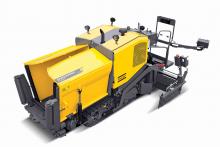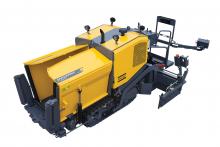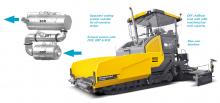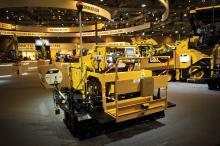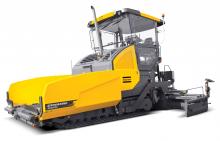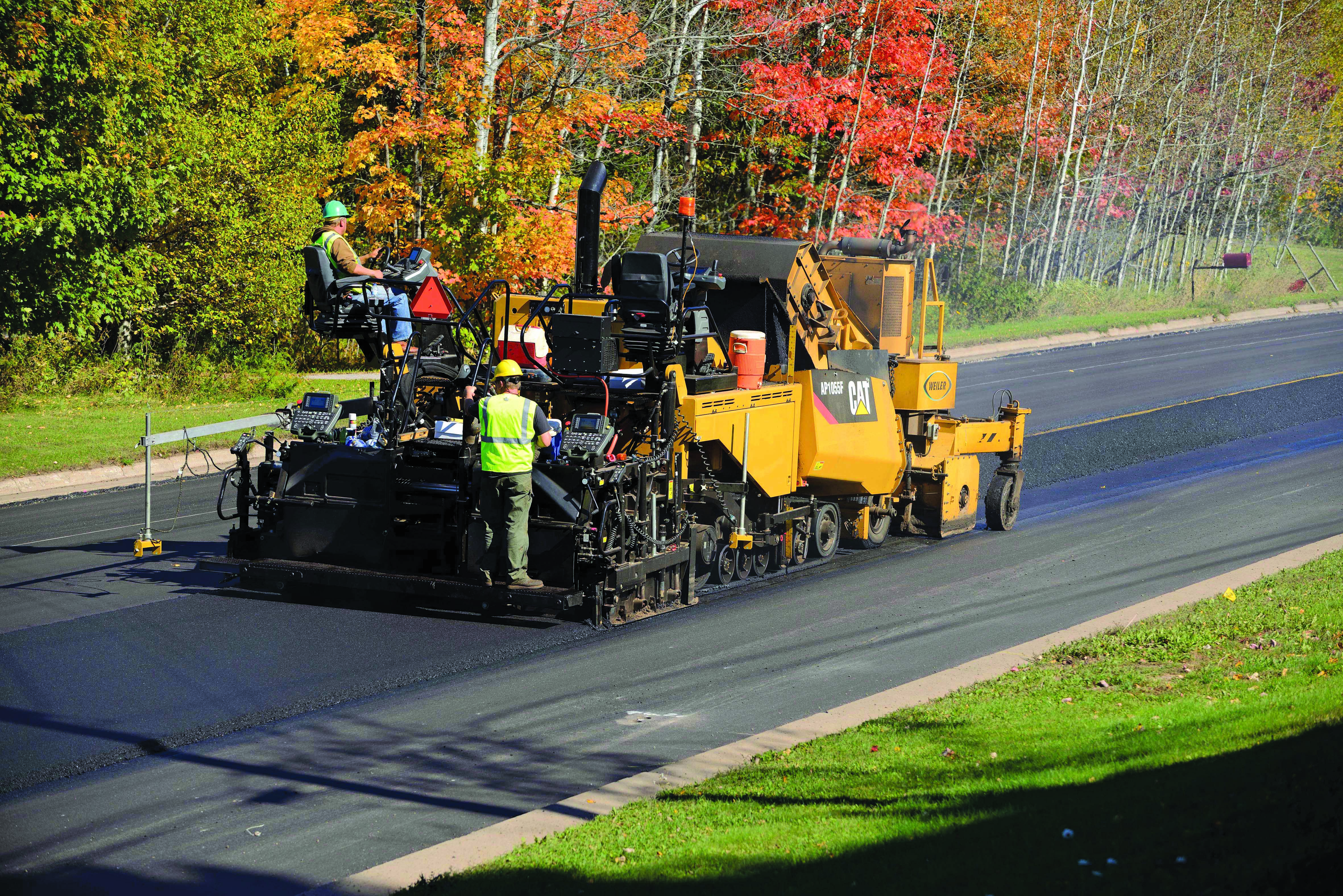
For all the key manufacturers in the asphalt paving segment, pressure is being brought to bear with regard to the development of new and more efficient machines. Both for US and European style of pavers, incremental improvements are being seen in machines. In keeping with regulations for Europe and North America, many of the new generation machines are now being powered by the latest low emission diesels. Manufacturers have managed to squeeze the bulky after-treatment systems required to meet emissions targets within the deck of these pavers, while also offering improved operator visibility of the hopper and screed. Even for emergent markets, there is greater emphasis on meeting emissions targets and with China for example now beginning implementation of tougher restrictions (broadly equivalent to Tier 3/Stage IIIA), this trend is continuing worldwide.
For
New engine technology is at the centre of the improvements for the F Series, which offer better fuel economy while maintaining high performance. Power comes from the latest Cat C7.1 diesel equipped with the firm’s advanced ACERT technology, which delivers 167kW and meets Stage IV/Tier 4 Final emissions regulations for Europe and North America, but without sacrificing output. On some F-Series models, a variant of the Cat C7.1 engine is also available that meets Tier 3/Stage IIIA emissions requirements and delivers up to 186kW.
To help lower fuel consumption, an eco-mode is standard and when used with the automatic speed control, this helps optimise engine speed. The combination boosts fuel economy and reduces sound levels while ensuring the machine runs smoothly. The system operates automatically when engine loads are high or if additional cooling is required.
The integrated generator also helps lower fuel consumption and was developed by the team that created the firm’s innovative D7E bulldozer. The generator is connected directly to the engine, operating as a central part of the machine. The SE60-Series screeds meanwhile are said to feature an optimised heat distribution that allows working temperatures to be reached in around 15 minutes, compared with the 30-45 minutes required for previous models. The firm also claims that fuel consumption is lowered as the engines will run at just 1,300rpm during the screed heating phase, whereas other machines require the diesel to be turning over at 2,200rpm, which uses more fuel.
The machines are said to be easy to operate with colour touchscreen displays, although frequently used functions are controlled by switches. A key feature is the screed heating diagnostics package, which allows paving work to continue in the event of a temperature sensor failing as the system will compensate automatically. Ratio control for the conveyors can be controlled from the screed, while the tractor operator can adjust mix height for increased versatility. A pendant control is offered that allows the screed operator to stand alongside the machine.
The F-Series pavers are available with the firm’s novel Mobil-Trac System (MTS) undercarriages, with fully-bogied support rollers that keep in contact with the surface even on rough ground, for maximum traction. The oscillating bogies are said to minimise deviations and tow-point movement, helping to boost mat smoothness. The MTS allows travel speeds that match the mobility of wheeled pavers, while offering the high traction expected of tracked pavers.
The wheeled F-Series pavers meanwhile offer six-wheel drive as an option to boost traction. A front wheel assist or four-wheel drive option increases front-wheel pull-force compared with previous models while new radial tyres offer further increases in traction.
Three screed options are available, the SE60 V, SE60 V XW and the SE60 VT XW variants. The XW models share common frame structures, with the V XW providing vibratory only and VT XW offering vibratory and tamper bars. Abrasion resistant steel plating is used to extend wear life, with the same material also used in the firm’s existing AS3301C, AS3251C and AS4252C screeds. The firm says that its SE60 V screed offers good ride and mat qualities, while being versatile for use in urban areas due to its compact and lightweight design, and the unit replaces the firm’s AS3301C vibratory screed. The XW-Series screeds also feature full hydraulic control of crown, extension slope and extension height at the full width of 10m, which is important for use in wide paving applications to deliver good mat texture and density.
Atlas Copco’s
Demand for road machinery has been good and he said, “In general 2014 has been a better year than 2013,” and he added that there are signs of continued improvement in Europe. “Poland is up and running again. We clearly see that in our results.”
However he cautioned, “A lot of authorities are still struggling with budgetary problems.”
Looking to the long term, Atlas Copco has been investing in the product line and Lauwers said, “We redesigned our small machines and replaced the F5 with the F12.”
The company is well ahead too with meeting emissions requirements for certain markets and Lauwers said, “Right now we can supply Tier 3 engines or Tier 4 Interim and we have already sold a number of Tier 4 Final machines. Certain markets are early adopters of Tier 4 Final. As for China Stage 3, we will be ready for that.”
The latest machine is the SD2550CS, which is a highway class paver and can handle widths up to 14m, while maximum production capacity is 1,100tonnes/hour. The heating system is driven by a 60kW generator while the efficient screed heating system is said to reduce the time needed to reach working temperatures. A range of screeds can be specified including the V5100/6000 TVE (tamper vibration) models, V5100/6000TVH (high compaction) units as well as the Dynapac R300TVE rigid type. The R300TVE is a tamper vibration rigid screed that has a basic width of 3m and can be extended using mechanical extension boxes up to a maximum width of 14m. In order to operate with variable paving width, the screed can also be offered with hydraulic extensions at the end, which are 1.3m wide and would extend to 2.6m maximum width. This screed is said to deliver a smooth surface finish as it has a rigid construction.
Other key features of the SD2550CS include a new ergonomically-designed dashboard that is said to be easier to use as well as the latest version of the firm's sophisticated Pave Manager 2.0 operating system. The machine has a 15tonne hopper meanwhile and can be used with the firm’s own MF2500CS feeder, allowing up to 30% gains in overall paving productivity. The machine is equipped with the firm’s VarioSpeed system, which optimises engine speed and helps cut fuel consumption by up to 15% as well as increasing machine life.
The company sees strong potential in China and Ichiro said, “We are also expanding into Asian countries and Russia too.”
“In Japan we enjoy a high market share,” although he added that the home market for asphalt pavers is fairly small, and while stable has few growth opportunities, which is why overseas sales are so important to the firm.
The firm has developed its new HA90C-2 from the previous HA90-C model, but this new model offers both improved performance and greater capabilities. This highway class paver shares features with the HA60C and retains some of the proven design from the earlier HA90C. Fumio Goto is chief staff manager at Sumitomo’s road machinery department and added, “Now we have the HA60C and HA90C-2 we hope we can expand our sales worldwide.”
A key focus for the Sumitomo pavers is the firm’s novel J Paver screed, designed with overlapping sections so as to offer a greater width range than conventional types. Customers have a choice of either LPG or electric heating options for the screeds. This has been further improved for the HA90C-2, with the new J-2875 model replacing the earlier design. The machine can also be specified with the smaller 2360 screed, which is fitted as standard to the firm’s current HA60C paver. Ichiro explained that the overlapping sections for the Sumitomo J-2875 screed allows it to offer working widths from 2.8-7.5m, while conventional types in this class would offer a width range from 3-6m.
When folded down for transport, the J-2875 screed is just 3m wide and this makes it easier to move around on road. Ichiro explained that some customers in markets where road/lane width is an issue would want to specify the HA90C-2 with the J-2360 screed, as it has a transport width of just 2.5m, a key benefit over some competing units that have minimum widths of 2.55m. Akira Kato is associate executive officer within the international sales department and said, “The big advantages of this design are the extension widths and the ease of transport.”
Power for the HA90C-2 comes from a 5.2litre
There is more potential for the Sumitomo paver range also. The company offers a bolt-on tack coat paver system for its wheeled paver models in the Japanese market and a new version could be developed for export based around the HA90C-2 should demand prove sufficient. The company has also developed a special GUSS paver for the Japanese market, the HGP55W, which is used for paving waterproof layers on steel bridge decks. But the company is considering building a version built around the HA60C for export.
German firm
While the SprayJet concept is intended for use in spreading emulsion layers prior to paving so as to deliver a better bond, it offers additional functionality. The package can be used to rehabilitate roads by replacing the surface course, a cost-effective method that is often used in some markets. According to Vögele, this package can be used to pave a thin layer of material directly on top of a layer of spray seal or tack coat.
The package comprises an emulsion tank and spraybars that are fitted onto the base machine. By having a single machine to carry out both the emulsion spraying and asphalt paving operations rather than two separate units, the company claims consistency is improved. The sophisticated control package that governs the asphalt paving operations also monitors the spraying system so that more precisely metred quantities are spread on the surface. As the emulsion layer is more homogenous, this helps boost paving quality and particularly at the edges, where consistency can vary when using separate machines for the task. Because the operation of the spray module is integrated into the machine’s ErgoPlus 3 control system, the quantities of emulsion can be strictly controlled in accordance with the specification of the paving mat.
The add-on module includes an insulated emulsion tank that has a capacity of 2,100litres and this is heated electrically to maintain the emulsion at the correct temperature to allow optimum spraying. A heated emulsion pump also agitates the emulsion continuously to ensure homogeneity.
An important feature of the bolt-on SprayJet unit is that it can be removed from the base paver as quickly as it can be fitted. The base machine can then be used as a conventional paver, while it is available with the firm’s different screed types and options for the Super 1800-3i model. This is a key point as it broadens the range of duties that the whole package can be used for, boosting overall machine utilisation.
With the SprayJet package fitted, the equipment offers a maximum spraying width of 6m but when used as a standard paver the screed width can be telescoped out to a width of 9m. The package includes several spray bars, with the front spray unit mounted between the carrier machine’s tracks (just to the rear of the push rollers) and featuring six separate nozzles. On either side of the paver articulated spray bars are fitted, with seven nozzles apiece. Another short spray bar with two nozzles meanwhile is fitted just behind the paver’s tracks. The layout of the spray bars is said to allow full emulsion coverage of the paving mat and the flow rate is adjusted by the control system to ensure precise operation, with rates varying from 0.3-1.6kg/m².
The nozzles spray the emulsion in a series of pulses, with the frequency of these pulses being controlled automatically and in proportion to factors such as spreading rate, paving speed and paving width. The control system is said to deliver a uniform film of emulsion at a low pressure (3bars) across the area to be paved, without any overlapping areas and reducing material wastage. Because of the design of the nozzles and the low pressure pulsed spraying the package is also said to operate cleanly, further reducing emulsion wastage as well as reducing the cleaning needed for the machine after work is complete.

